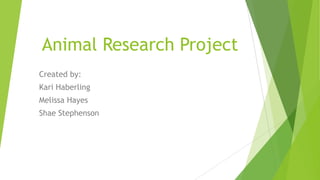
Animal Research Popplets
- 1. Animal Research Project Created by: Kari Haberling Melissa Hayes Shae Stephenson
- 2. Third Grade Language Standards W.3.2. Write informative/explanatory texts to examine a topic and convey ideas and information clearly. W.3.2b. Develop the topic with facts, definitions, and details. W.3.7. Conduct short research topics that build knowledge about a topic.
- 3. Third Grade Science Standards 3.L.1.2. Students are able to identify characteristic features of animals and their related functions in relation to their environment. 3.L.2.1. Students are able to explain how animals instinctively meet basic needs in their environment.
- 4. Third Grade ISTE Standards 1.b. Create original works as a means of personal or group expression. 2.a. Interact, collaborate, and publish with peers, experts, or others employing a variety of digital environments and media. 2.b. Communicate information and ideas effectively to multiple audiences using a variety of media and formats. 3.b. Locate, organize, analyze, evaluate, synthesize, and ethically use information from a variety of sources and media. 5.a. Advocate and practice safe, legal, and responsible use of information and technology. 6.c. Troubleshoot systems and applications. 6.d. Transfer current knowledge to learning of new technologies.
- 5. Students will work in groups of two or three to complete the assignment. The teacher will pair the students based on their academics, ability to work with others, and their technology skills. Cooperative Learning Groups
- 6. Teacher Materials Copies of student rubric List of online resources Student laptops Project guidelines List of student groups Sample popplet
- 7. Student Resources and Materials search.creativecommons.org Students will go to the South Dakota State Library webpage to access the following online resources World Book Kids World Book Student SIRS Discoverer Student Materials 1. computer, rubric, notebook, pencil, checklist of required information.
- 8. Learning Outcomes Students will create a concept map with the information they collect on the website www.popplet.com . Students will work in groups to research an animal of their choice. Students will cite all sources used. Students will collect the following information: Animal’s name Animal’s physical characteristics Animal’s habitat Animal’s diet Interesting facts Images
- 9. Description of final assignment The final project will be completed on www.popplet.com The required elements will include: The animal’s name Three details about the animal’s physical appearance A minimum of one image of the animal from the creative commons website Three details about the animal’s habitat Three details about the animal’s diet Three interesting facts about the animal
- 10. Instructional Procedures Day one Introduce the animal research project to the students. Put students in pre-assigned groups Give students time to choose an animal for their topic
- 11. Instructional Procedures continued Day two Students will research their animal’s physical appearance using the provided technology resources. Students will record a minimum of three facts they learned about their animal’s physical appearance.
- 12. Instructional Procedures continued Day three Students will research their animal’s habitat using the provided technology resources. Students will record a minimum of three facts they learned about their animal’s habitat.
- 13. Instructional Procedures continued Day four Students will research their animal’s diet using the provided technology resources. Students will record a minimum of three facts they learned about their animal’s diet.
- 14. Instructional Procedures continued Day five Students will research their animal to find interesting facts using the provided technology resources. Students will record a minimum of three interesting facts they learned about their animal.
- 15. Instructional Procedures continued Days 6 and 7 Students will use the information they gathered to create a popplet. A sample popplet can be viewed at popplet.com/app/#/1758646
- 16. Rubric
- 17. Peer Review